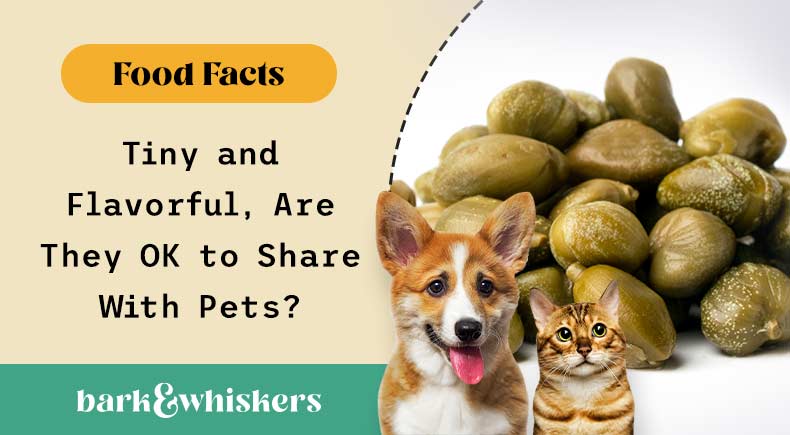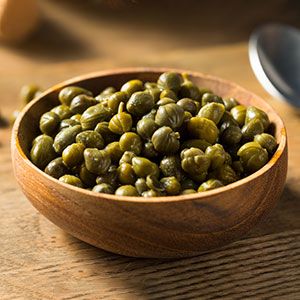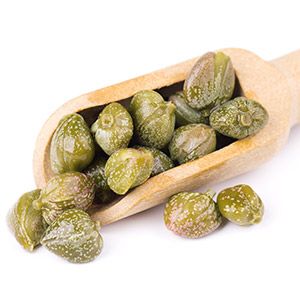Capers: Tiny and Flavorful, Are They OK to Share With Pets?
A staple in Mediterranean cooking, this small food packs big flavors and a wide array of antioxidants. But keep this caveat in mind before sharing it with your furry best friend.

STORY AT-A-GLANCE
- Capers are the unopened flower buds of the caper bush (Capparis spinosa), a perennial plant that’s native to the Mediterranean region
- Capers are the “richest known natural source of quercetin,” which may help inhibit the release of inflammatory mediators and reduce the severity of atopic dermatitis in dogs
- Capers are also considered an excellent source of rutin, which exhibits anti-inflammatory, antioxidative and anti-apoptotic properties, according to animal studies
- If you want to share capers with your pet, make sure to choose capers that are packed in olive oil instead of salt-cured or brined varieties
Editor's Note: This article is a reprint. It was originally published March 22, 2023.
When many people think of capers, the first thing that comes to mind are the small, green pellet-shaped buds sold in jars at grocery stores. However, capers are technically the unopened flower buds of the caper bush (Capparis spinosa), a perennial plant that’s native to the Mediterranean region.1
They’re known for the burst of sharp piquant taste they lend to sauces, salads, main entrees, pasta and pizza,2 but have you ever wondered if they can be enjoyed by pets as well? Continue reading to learn about the nutritional value of capers and the proper way to offer them to your furry best friend.
Caper Fun Fact

Capers are too small to be plucked by a machine, so they’re harvested by hand, which is why the smaller they are, the more expensive they become.3
Powerful Phytochemicals Found in Capers
One of capers’ most notable benefits is the variety of health-promoting bioactive compounds they contain, which exhibit anti-inflammatory, antioxidant, antiobesity, antibacterial, antitumor and anti-hepatotoxic activities.4,5 According to a study published in the journal Plants (Basel):6
“Capers are a very rich source of phenolic compounds, especially flavonols, flavan-3-ols, and hydroxycinnamic acid. Total flavonols in caper flowers comprise a mixture of different glycosylated quercetin, isorhamnetin, kaempferol, and myricetin derivatives ... Small caper flowers of the size below 7–8 mm were richer in flavonols than larger flowers.”
Capers are the “richest known natural source of quercetin,” according to a study published in Nutrients.7 This flavonoid has been found to help inhibit the release of inflammatory mediators and reduce the severity of atopic dermatitis in dogs.8 Meanwhile, kaempferol exerts neuroprotective action through different mechanisms of action, such as by inhibiting reactive oxygen species, modulating endogenous antioxidants and regulating brain-derived neurotrophic factor (BDNF), which is vital for neural plasticity.9
As for myricetin, a study published in the Journal of Cellular Physiology found that it helped decrease cell proliferation and DNA replication of canine osteosarcoma cells while inducing apoptosis, making it a “potentially effective ... therapeutic agent to prevent and control progression of canine osteosarcoma.”10
Rutin: A Neuroprotective Compound in Capers
Capers are considered an excellent source of rutin, which is a glycoside of quercetin. According to a study published in Scientific Reports, rutin “has been reported to have a beneficial role in controlling various diseases such as hypertension, arteriosclerosis, diabetes, and obesity.”11 Animal studies have also demonstrated the anti-inflammatory, antioxidative and anti-apoptotic properties of this compound.12
Moreover, a study in the journal Oxidative Medicine and Cellular Longevity highlighted the neuroprotective properties of rutin, including reducing inflammatory cytokines and promoting antioxidant enzyme activities. The researchers concluded that “rutin may be a promising neuroprotective compound for the treatment of neurodegenerative diseases.”13
Did You Know?

The white spots on the surface of pickled capers are crystallized rutin!14
Despite Capers’ Benefits, Consider This Caveat First
Fresh capers are not toxic to your pet. However, to some their flavor may be “unpleasantly astringent”15 and “extremely bitter.”16 To make them more palatable, capers are often pickled in brine or cured with salt.17 Because of this, most store-bought pickled capers contain high amounts of sodium (a whopping 202 milligrams per 1-tablespoon serving18).
In fact, when cooking human dishes with capers, it’s generally recommended to add the buds sparingly and reduce the amount of salt in the recipe accordingly. For this reason, it’s best to avoid offering capers to your pet straight out of the jar, especially in high amounts.
Keep in mind that excessive salt intake can result in salt poisoning, which causes symptoms such as vomiting, diarrhea, lethargy, loss of appetite, “drunk” walking, excessive thirst or urination, kidney problems, abnormal fluid accumulation, tremors and coma.19
How to Choose Capers and Safely Offer Them to Your Pet
“If you want to share capers with your pet, make sure to choose capers that are packed in olive oil instead of salt-cured or brined.”
However, oil-packed capers are more difficult to find.20 If the capers you have are pickled with salt, make sure to desalinate them thoroughly before offering them to your pet. To do this, soak them in water for at least 10 hours, changing the water regularly until the capers no longer taste salty.21
Because capers taste pungent, some pets may not like them at all. If your pet is the type that eats anything, you can try offering them a caper on its own. However, if you have a picky eater, you can add a small number of capers when making bone broth or use them as an ingredient in your pet’s DIY snack, mixed with other healthy foods that can mask their flavor.
And remember: Only offer capers as occasional treats or toppers to your pet’s nutritionally balanced homemade meal, and not as a part of their daily food, keeping in mind that healthy "extras" should make up less than 10% of your pet’s daily caloric intake.
Capers aren’t widely grown in the U.S., but some parts of California have had success with cultivation.22 If you happen to find fresh, uncured capers at your local farmers market, or if you have a caper plant in your own garden, you can add a small amount of caper buds when making a batch of homemade fermented vegetables.
This allows your family (and your pets) to obtain the benefits of not just capers but also other fermented veggies, without worrying about consuming excessive salt. Before fermenting capers, you need to soak them in water for three days at room temperature, changing the water every day, to reduce their astringent flavor.23
You can use celery juice as your brine for the fermented vegetables, as it contains natural sodium, which eliminates the need for additional salt. When serving fermented capers and veggies to your pet, start with small amounts until you build up their tolerance to avoid stomach upset.
Top Caper-Producing Countries

Morocco leads the world’s production and export of capers, followed by Tunisia, Egypt, Spain, Italy, Greece, Turkey and Syria.24

Is Growing Capers Sustainable?
Capers are considered sustainable because they take up very few resources to grow. The caper bush can flourish without any synthetic fertilizers and can even thrive in the wild. They’re also arid-loving plants, so they don’t require large amounts of water. And since they’re resilient against pests and diseases, they’re less likely to be sprayed with pesticides.25
Sources and References
- 1 The Spruce Eats, September 7, 2022
- 2 The Spruce Eats, May 14, 2019. All About Capers
- 3 Serious Eats, August 10, 2018
- 4,6 Plants (Basel). 2019 Dec; 8(12): 539
- 5 Fitoterapia. 2011 Mar;82(2):93-101
- 7 Nutrients 2023, 15(3), 623
- 8 J Cell Biochem. 2019 Oct;120(10):17449-17458
- 9 Front Pharmacol. 2020; 11: 565700
- 10 J Cell Physiol. 2018 Sep;233(9):7457-7466
- 11 Scientific Reports volume 10, Article number: 8884 (2020)
- 12 Front Vet Sci. 2022; 9: 907299
- 13 Oxid Med Cell Longev. 2018 Jun 27;2018:6241017
- 14,25 FoodPrint, Real Food Encyclopedia | Capers
- 15,23 The Spruce Eats, May 5, 2019
- 16 University of Illinois, April 19, 2019
- 17 The Spruce Eats, May 14, 2019
- 18 USDA FoodData Central, Capers, canned
- 19 Pet Poison Helpline, Salt
- 20 Epicurious, February 4, 2022
- 21 Vinegar Shed, Capers in Salt
- 22 East Bay Times, September 30, 2008
- 24 Agronomy 2019, 9(6), 303











